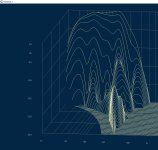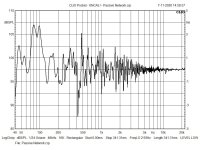This makes a lot of sense, I did not think to combine the 2 perspectives. I do believe that in my situation, horizontally, Globally, things are as they should be, that is, nice and smooth. The mouth of this horn is truncated, on the vertical axis.Not so fast, these things can be real issues. For example the resonance of a horn caused by reflections at the mouth is a standing wave issue that cannot be corrected globally. One can correct the FR (and hence the GD/Delay) at a specific spatial point, but it cannot be corrected globally. This is why the mouth treatment is critical - far more so than "cutoff".
Random Question; Blackman-Harris 7.... Do you find this windowing favorable?
Last edited:
Also true... We should not be concerned with resonances from a Slot loaded woofer.

I know from experience that something is skewed here. There's a lot of missing info about this measurement, and the aberrations in decay here are -15 to -20db. The main thing is that this measurement does not show a clear view of how peak level is different in time, in order to move the decay out,k in time, as well.
I know from experience that something is skewed here. There's a lot of missing info about this measurement, and the aberrations in decay here are -15 to -20db. The main thing is that this measurement does not show a clear view of how peak level is different in time, in order to move the decay out,k in time, as well.
You are going to have to work with me. REW can do excess, I personally can't do it cause I don't know how... I see the trace options available for Min and Excess, but my measurement isn't showing me any traces....
View attachment 1290220
I'm not sure what smoothing @bikinpunk used here, if any.... 12,24, and 48 are common though.
View attachment 1290224
Isn't your above measurement 1/6 smoothed? If so, thats pretty heavy averaging. If I switch my settings to 1/6th I get this;
View attachment 1290222
Yes 1/6 here same 1/24th it does show more peaks but the trend is clearly the same. What scale window size is that? Mine posted are +/- 5 m sec . You can see the DSP system latency in the M2 measurement. I am using the posted B/L graph as the Threshold for audibility considering less than is OK.
Rob
Attachments
Sorry @camplo,
it appears to me that i have to argue against your continuous effort to defend your two way setup with the W dipole and the big horn at any cost
i have here some measurement of a well known guy in the german DIY scene hoping that i do not get trouble with copyright issues
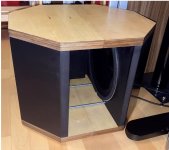
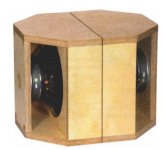
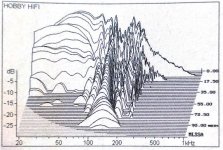
the WCD plot of my simple N profile dipole looks much better, with a W profile BMC dipole the decay plot shows massive resonances already above 100 Hz
the W profile so called Ridthaler dipole is meant to work only as subwoofer for sure
take your time and make a decent measurement outside to be able to measure the speaker and not the room where the speaker is placed and you will see yourself
So far - so good, Stefano
it appears to me that i have to argue against your continuous effort to defend your two way setup with the W dipole and the big horn at any cost
i have here some measurement of a well known guy in the german DIY scene hoping that i do not get trouble with copyright issues



the WCD plot of my simple N profile dipole looks much better, with a W profile BMC dipole the decay plot shows massive resonances already above 100 Hz
the W profile so called Ridthaler dipole is meant to work only as subwoofer for sure
take your time and make a decent measurement outside to be able to measure the speaker and not the room where the speaker is placed and you will see yourself
So far - so good, Stefano
I don't have a DipoleW dipole
If you read what was just discussed regarding resonance you will find that your measurements are misleading. They do not account for Group delay. In other words, they do not show a clear view of rise time and fall time.... The second issue is the decay in relevance to cycle time.... the third issue is that because these are bass frequencies, the rooms decay is a factor, with the rooms decay, masking what you see here. When you combine all of these aspects you arent left with something that is easily perceivable by ear. By eye, this looks like the ring of death....
Last edited:
This is a small detail, there is still a slot resonance, but within the last page or two, we are discussing that Cutoff, is not a real thing, in terms of what has been suggested in history. The slot resonance is no different than the quarter wave resonance of a horn. The resident expert, who has much higher standards than myself, but more importantly, the education to back it up, says "Cutoff" is a fictional idea that doesn't exist in reality ".... We are discussing the cutoff, he goes on to say "The issue is that all waveguide/horns show very low efficiency at LFs (below "cutoff" if you must) and as such require ever more excursion from the driver". In this case, the drivers in the horn, have much more LF efficiency to give, as they are not relying on the horn to generate it, as a compression driver does. As of most recently, he points out that if there is another issue, it would be of directivity, with the potential issue of a non constant directivity. Being that we are dealing with such low frequency, there is even less of a chance of issue.
Ok, I am getting a little ahead of myself, With an offset horn, there is the known issue of a flawed FR, due to cancellation via reflection. I have this issue, to a certain degree. and I am working on fixing it... as there are several ways to address it.
Last edited:
You realize of course that I was referring to waveguide/horns and not subs. To use that phase in a post about subs is illogical."Cutoff" is a fictional idea that doesn't exist in reality ".
The slot resonance is very different from a 1/4 wave resonance since it is a Helmholtz resonator and not a 1/4 wave. As such it would have no "cutoff", just a single simple resonance (to first order.) In a horn the first resonance is almost always a Helmholtz resonance of the diaphragm coupling chamber compliance against the acoustic mass of the horn. Higher up in frequency and standing wave resonances can appear if the mouth is not properly terminated, but the Helmholtz resonance will always be there independent of the mouth termination.The slot resonance is no different than the quarter wave resonance of a horn.
Isn't quarter wave resonation a standing wave regardless of the mouth? How can there be any resonance in regards of what quarterwave and helmholtz do, without standing waves?
I don;t think I said that right.... There are standing waves, from every dimension of the horn... Axial included.
I don;t think I said that right.... There are standing waves, from every dimension of the horn... Axial included.
Last edited:
Think of a pop bottle. Blow across it and it resonates. This is a helmholtz resonance and there is no 1/4 wave reflection until very high up. This is just the acoustic mass of the neck resonating with the compliance of the bottle. No 1/4 wave involved. There is no "standing wave" just a mass/compliance resonance. If the neck is very long then a 1/4 wave resonance can occur from reflections of the mouth of the neck, but this is very distinct from the Helmholtz resonance.
The above example is almost identical to a horn system where both helmholtz and standing wave resonances occur.
The above example is almost identical to a horn system where both helmholtz and standing wave resonances occur.
This is interesting, but before we get far off into where or how to draw the line between two, what I meant to say, when I related Helmholtz to Quarter wave, is that both boost initial input, and there is a filter knee, with the same characteristics of GD and Decay. These characteristics are not an issue of accuracy and perception, though it may look detrimental depending on the measurements one chooses to present.
"The issue is that all waveguide/horns show very low efficiency at LFs (below "cutoff" if you must) and as such require ever more excursion from the driver"To use that phase in a post about subs is illogical.
Because why? If you have a FLH thats fundamental is 30hz, LF efficiency below 30hz is an issue...
153hz is still bass. A ppsl is a front loaded horn, it is a 4th order bandpass no less than a tractrix horn on a compression driver. My ppsl has a 1/4wl resonance at ~150hz. Cutoff is usually pointing to spectrum area directly left of the fundamental resonance, where boost is falling off.
My point was that LF efficiency isn't an issue but also, ringing is not an issue. There is ringing at the filter knee no different than any other horn, and as Gedlee stated playing through "cutoff" isn't an issue.
He was speaking about possibly tweeter horns, but I don't see why this wouldnt apply to all horns unless it was a really bad design signified by a very large GD spike.
I think I rather look at ms of duration instead of cycle time. Contrary to what I once thought, cycle time isn't a valid tell of decay character. In bass in particular where cycle time is much longer, and additional cycle or two is very significant vs 400hz for example. According to my research about 10ms difference in signal length is a good threshold to say generally we can perceive a difference, though it is not huge. Then consider that is with full signal not a decaying signal point of reaching -30db, which should be even harder to perceive you would think. Then consider that we are dealing with test signals not music....
After Frequency response is smoothed, these ringing issues might be very very subtle if not imperceptible, though easily seen with the eye, with test tones... and if best, very subtle with test tones, they will not live to perceptibility within music
My point was that LF efficiency isn't an issue but also, ringing is not an issue. There is ringing at the filter knee no different than any other horn, and as Gedlee stated playing through "cutoff" isn't an issue.
He was speaking about possibly tweeter horns, but I don't see why this wouldnt apply to all horns unless it was a really bad design signified by a very large GD spike.
I think I rather look at ms of duration instead of cycle time. Contrary to what I once thought, cycle time isn't a valid tell of decay character. In bass in particular where cycle time is much longer, and additional cycle or two is very significant vs 400hz for example. According to my research about 10ms difference in signal length is a good threshold to say generally we can perceive a difference, though it is not huge. Then consider that is with full signal not a decaying signal point of reaching -30db, which should be even harder to perceive you would think. Then consider that we are dealing with test signals not music....
After Frequency response is smoothed, these ringing issues might be very very subtle if not imperceptible, though easily seen with the eye, with test tones... and if best, very subtle with test tones, they will not live to perceptibility within music
Last edited:
As usual, I have trouble sorting out your position or question when you say "when I related Helmholtz to Quarter wave, is that both boost initial input, and there is a filter knee, with the same characteristics of GD and Decay. " They are very different things actually and do not act in the same ways.This is interesting, but before we get far off into where or how to draw the line between two, what I meant to say, when I related Helmholtz to Quarter wave, is that both boost initial input, and there is a filter knee, with the same characteristics of GD and Decay. These characteristics are not an issue of accuracy and perception, though it may look detrimental depending on the measurements one chooses to present.
A Helmholtz resonance is a two degree of freedom problem, mass/spring, there is a rise and then a fall with F about resonance. That's it. It is completely minimum phase lumped parameter kind of stuff. Not so with standing waves, they are waves that propagate and reflect back onto themselves in a never ending (I mean they do eventually always damp out) steam but radiating off waves. The characteristics of GD and decay need not be anything alike.
I am trying, let me explain.
"when I related Helmholtz to Quarter wave, is that both boost initial input, and there is a filter knee, with the same characteristics of GD and Decay"
There is a boost in output, centered around the fundamental of the resonance, whether caused by Helmholtz or Quarter wave, seen by an increase in efficiency, in the excursion to output ratio, centered are the fundamental. Both resonance types have the same filter characteristics, a spike in GD/Decay at the knee of the filter.
I don't understand? in this first TL we see a huge GD spike at the fundamental

At the Fundamental of this BR we see a huge GD spike at the fundamental

If I where to pull up the spectrogram of TL and BR there would be excess decay centered at the fundamental resonance. Its not literally identical but it is the same, in character, as in, spike in GD/Decay...
These are the aspects that I was saying that Helmholtz and Quarterwave tuning have in common. I brought these aspects into light because of your comment; "This is not an issue. "Cutoff" is a fictional idea that doesn't exist in reality - there is no cutoff to a real waveguide. The issue is that all waveguide/horns show very low efficiency at LFs (below "cutoff" if you must) and as such require ever more excursion from the driver, which can cause problems." Ok then, well the reason why others in the past, have said not to bring the passband near or below the past band is because of the GD/decay spike at the fundamental. All I am trying to say is that your comment is suggesting that the GD/Decay near resonance are not detrimental to accuracy. You said "The issue is all waveguides/horns show very low efficiency (below cutoff)" and thats the issue. That suggest that the issue is not GD/Decay....Ok I accept that. So this applies to BR also.... its GD/Decay are about identical to Quarter wave tuned enclosures. That was a side note. I just wanted to cover all bases. If all is true then that also means, there is no issue of GD/Decay of my PPSL. Which is what I was explaining to the other gentleman.
From there I tried to explain why, what appears easily to the eye, that is, spike in GD/Decay, is not easily perceivable to the ear. The best learning I can pass on to anyone reading is to pull up REW on the computer, use a good pair of headphones, and go to town with the signal generator. From what I think I have figured out. Even though the excess GD/Decay at the fundamental of a Horn is easily seen on a CSD chart... First, the time to peak energy is offset, so the decay time from peak energy till -15, -30, etc, isn't as bad is it may appear. If we align GD, things will appear tighter on the chart. There does, end up being a longer decay time after GD is aligned but it is not readily perceivable like it is easily visible, after or before alignment. If there are resonant notes, from the horn/ppsl etc, that live under the Schroeder frequency, these are potentially masked by the rooms decay, furthering the unlikely hood of one being able to perceive them. At the very worst, might they be subtly detectable with test signals in a clinical listening environment and with complex signal (music) they are yet again, undetectable. Frequency Response is the most important aspect, maybe the only aspect, to worry about, given that the system is designed for low excursion and the aspects of dispersion are taken care of. This is not to suggest that Decay character can't be an issue, its just not because of Cutoff... The ability to hear the diaphragm material is a thing, possibly if the diaphragm is not well designed.... and 700hz-7khz is likely the most dangerous place to have an issue of decay.

"when I related Helmholtz to Quarter wave, is that both boost initial input, and there is a filter knee, with the same characteristics of GD and Decay"
There is a boost in output, centered around the fundamental of the resonance, whether caused by Helmholtz or Quarter wave, seen by an increase in efficiency, in the excursion to output ratio, centered are the fundamental. Both resonance types have the same filter characteristics, a spike in GD/Decay at the knee of the filter.
The characteristics of GD and decay need not be anything alike.
I don't understand? in this first TL we see a huge GD spike at the fundamental
At the Fundamental of this BR we see a huge GD spike at the fundamental
If I where to pull up the spectrogram of TL and BR there would be excess decay centered at the fundamental resonance. Its not literally identical but it is the same, in character, as in, spike in GD/Decay...
These are the aspects that I was saying that Helmholtz and Quarterwave tuning have in common. I brought these aspects into light because of your comment; "This is not an issue. "Cutoff" is a fictional idea that doesn't exist in reality - there is no cutoff to a real waveguide. The issue is that all waveguide/horns show very low efficiency at LFs (below "cutoff" if you must) and as such require ever more excursion from the driver, which can cause problems." Ok then, well the reason why others in the past, have said not to bring the passband near or below the past band is because of the GD/decay spike at the fundamental. All I am trying to say is that your comment is suggesting that the GD/Decay near resonance are not detrimental to accuracy. You said "The issue is all waveguides/horns show very low efficiency (below cutoff)" and thats the issue. That suggest that the issue is not GD/Decay....Ok I accept that. So this applies to BR also.... its GD/Decay are about identical to Quarter wave tuned enclosures. That was a side note. I just wanted to cover all bases. If all is true then that also means, there is no issue of GD/Decay of my PPSL. Which is what I was explaining to the other gentleman.
From there I tried to explain why, what appears easily to the eye, that is, spike in GD/Decay, is not easily perceivable to the ear. The best learning I can pass on to anyone reading is to pull up REW on the computer, use a good pair of headphones, and go to town with the signal generator. From what I think I have figured out. Even though the excess GD/Decay at the fundamental of a Horn is easily seen on a CSD chart... First, the time to peak energy is offset, so the decay time from peak energy till -15, -30, etc, isn't as bad is it may appear. If we align GD, things will appear tighter on the chart. There does, end up being a longer decay time after GD is aligned but it is not readily perceivable like it is easily visible, after or before alignment. If there are resonant notes, from the horn/ppsl etc, that live under the Schroeder frequency, these are potentially masked by the rooms decay, furthering the unlikely hood of one being able to perceive them. At the very worst, might they be subtly detectable with test signals in a clinical listening environment and with complex signal (music) they are yet again, undetectable. Frequency Response is the most important aspect, maybe the only aspect, to worry about, given that the system is designed for low excursion and the aspects of dispersion are taken care of. This is not to suggest that Decay character can't be an issue, its just not because of Cutoff... The ability to hear the diaphragm material is a thing, possibly if the diaphragm is not well designed.... and 700hz-7khz is likely the most dangerous place to have an issue of decay.
Last edited:
I hardly ever understand fully what you are talking about - we have different vocabularies for most of the technical items. I just try and point out where I think that you may be making a mistake. As far as the perception of GD goes, this was studied by Brian Moore many years ago. He concluded that for the most part GD is not audible. It is important to note however that he did understand that the audibility of GD would increase with SPL, hence it will be audible at some SPL level, but not at the more common levels.
As to your concern about Decay, I don't see that as relevant at all as it is completely tied to FR and GD and not an independent effect.
As to your concern about Decay, I don't see that as relevant at all as it is completely tied to FR and GD and not an independent effect.
I thank you and do appreciate your patience.


I understand to a degree. I agree mostly. The start up transient of any frequency is broadband in frequency generation, The higher the group delay the less of this broadband content is generated. This changes the impact of the initial sound. I think this is a topic of Timbre. I can adjust "group delay" by changing attack which is the time to peak energy. Experimenting with attack time and repeatedly starting signal from silence, at different frequencies, is how I come to this conclusion. The sample is a sine wave. On my spectrum analyzers I can see the broad band content of the start up transient change as I increase the attack time, and I can hear the difference. What this means? I don't know.... according to AI this broadband content is generated in nature not just the digital realm. So if this is timbre, I can hear it. Its effects are much more noticeable in the higher frequencies. I am on headphones for this experiment.
I can only change attack time, over the whole spectrum so my results are exaggerated. Under normal circumstances, I agree, GD is likely a small issue...
As to your concern about Decay, I don't see that as relevant at all as it is completely tied to FR and GD and not an independent effect.
I understand to a degree. I agree mostly. The start up transient of any frequency is broadband in frequency generation, The higher the group delay the less of this broadband content is generated. This changes the impact of the initial sound. I think this is a topic of Timbre. I can adjust "group delay" by changing attack which is the time to peak energy. Experimenting with attack time and repeatedly starting signal from silence, at different frequencies, is how I come to this conclusion. The sample is a sine wave. On my spectrum analyzers I can see the broad band content of the start up transient change as I increase the attack time, and I can hear the difference. What this means? I don't know.... according to AI this broadband content is generated in nature not just the digital realm. So if this is timbre, I can hear it. Its effects are much more noticeable in the higher frequencies. I am on headphones for this experiment.
I can only change attack time, over the whole spectrum so my results are exaggerated. Under normal circumstances, I agree, GD is likely a small issue...
Last edited:
My results being exaggerated, I am not sure, maybe not. When I hit a key, the synth sends a pure sine signal. The broadband content generated from the start up transient, is a separate event from the original signal wave form... that would make the phenomenon I described above of the broadband content generated vs group delay, true to real life.
I've read comments suggesting that, judging Group delay on headphones is unlike doing so on loudspeakers and that it would take a system of high directivity to bring the results closer to that of headphones?
"The conditions under which it can be audible are headphones (of course) and directional loudspeakers in not too reflective a room. Early room reflections make GD inaudible, but if these early reflections are controlled then it can be audible. BUT the bigger effect is that the audibility of GD is SPL level dependent. In other words it may be audible at higher SPLs but NOT at lower SPLs. This is a critical factor if you want to talk about "audibility" because now you have to talk about "at what sound level"."
"Thats very interesting and I tend to agree the more reasonable way to look at it. I also tedn to think that sharp changes in the GD would be the more audible rather than a gradual and broad GD effect. But those kinds of details have not been studied. The most pertinent study is the latest one by Brian Moore (not first author - don;t rememebr the others) in JAES. They claim no audibility under normal circumstances. But I find their normal circumstances to not be what I do so I tend to think that there will be situations where GD could be audible in practice. Two cyles of GD at LFs is a lot of delay."
The accuracy of such, could play a factor in a sound engineers ability to finely adjust Compression/limiting yet it is still likely a small issue in the grand scheme of things, with a well designed system. Main attractions would be the placement of quarterwave/helholtz resonance and crossovers... Not that I've got it all figured out... I still feel the need to avoid the critical frequency area 700-7khz with a XO. I also forget that GD is corrected in FIR filtering...
I've read comments suggesting that, judging Group delay on headphones is unlike doing so on loudspeakers and that it would take a system of high directivity to bring the results closer to that of headphones?
"The conditions under which it can be audible are headphones (of course) and directional loudspeakers in not too reflective a room. Early room reflections make GD inaudible, but if these early reflections are controlled then it can be audible. BUT the bigger effect is that the audibility of GD is SPL level dependent. In other words it may be audible at higher SPLs but NOT at lower SPLs. This is a critical factor if you want to talk about "audibility" because now you have to talk about "at what sound level"."
"Thats very interesting and I tend to agree the more reasonable way to look at it. I also tedn to think that sharp changes in the GD would be the more audible rather than a gradual and broad GD effect. But those kinds of details have not been studied. The most pertinent study is the latest one by Brian Moore (not first author - don;t rememebr the others) in JAES. They claim no audibility under normal circumstances. But I find their normal circumstances to not be what I do so I tend to think that there will be situations where GD could be audible in practice. Two cyles of GD at LFs is a lot of delay."
The accuracy of such, could play a factor in a sound engineers ability to finely adjust Compression/limiting yet it is still likely a small issue in the grand scheme of things, with a well designed system. Main attractions would be the placement of quarterwave/helholtz resonance and crossovers... Not that I've got it all figured out... I still feel the need to avoid the critical frequency area 700-7khz with a XO. I also forget that GD is corrected in FIR filtering...
Last edited:
No, it is not.A ppsl is a front loaded horn,
Yes, it is... sort of.A ppsl is (...deleted...) a 4th order bandpass
No, it is not.A ppsl is (...deleted...) a tractrix horn on a compression driver.
- Home
- Loudspeakers
- Multi-Way
- Is it possible to cover the whole spectrum, high SPL, low distortion with a 2-way?
